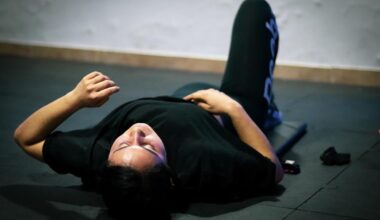Balancing Strength and Mobility in Functional Fitness
Functional fitness integrates training for strength, mobility, and endurance. Strength training is crucial for improving performance in daily activities by enhancing muscle power. Incorporating functional movements prepares individuals for real-world tasks. Focus on exercises that mimic movements like squatting, pulling, and pushing. Such exercises strengthen major muscle groups effectively. Ensuring balance in strength and mobility promotes better performance overall. It prevents injuries and allows for a more sustainable fitness routine. Warm-up and mobility exercises before strength training are vital to maximize benefits. These can include dynamic stretches aimed at increasing joint mobility. They can strengthen connective tissue as well, which offers greater stability. A balanced routine should incorporate adequate rest to allow for muscle recovery. Strength training sessions are often performed two to three times weekly. Each session might focus on different muscle groups, ensuring overall strength development. Benefits extend beyond just lifting weights. Improved posture, better body mechanics, and enhanced athletic performance are achievable with dedicated practice. Aim for consistency and varied exercises to prevent plateaus and keep training engaging. Familiarize yourself with proper techniques to minimize risk when lifting weights.
The Importance of Mobility
Mobility refers to the ability of joints to move freely through their full range. It is often overlooked in traditional strength training programs, but it is equally crucial. Improved mobility enhances performance in exercises and reduces the risk of injuries. To ensure comprehensive training, integrate both strength and mobility exercises. Examples of mobility exercises include hip openers, shoulder dislocates, and ankle mobility drills. These exercises improve flexibility and joint health, which are essential for longevity in fitness. Consistently incorporating mobility work can lead to better muscle function. Increased mobility allows for deeper squats and more efficient lifts. Additionally, it can reduce muscle soreness after intense workouts. Combining strength and mobility training encourages biomechanical efficiency. This leads to functional strength gains that are transferable to everyday activities and sports. Moreover, it keeps workouts interesting and challenging. Engaging in mobility-focused classes or sessions can further enhance your skills. These often include yoga, Pilates, or specific dynamic movement training. When training, it is essential to listen to your body and adjust as necessary. Integrating foam rolling and stretching can further assist in recovery, ultimately improving performance overall.
Strength training isn’t solely about lifting heavy weights. It includes various forms such as resistance training and bodyweight exercises. Each method provides unique advantages. Resistance bands, for example, are excellent for building strength without the need for heavy weights. They enhance flexibility while strengthening muscles. Bodyweight exercises like push-ups and squats engage numerous muscle groups simultaneously. They train balance and stability, essential for functional fitness. To truly balance strength and mobility, utilize a variety of training tools, techniques, and modalities. This approach caters to diverse fitness levels and goals. Additionally, incorporating core strengthening exercises creates a solid foundation for all movements. A strong core stabilizes your body, enhancing control and precision during lifts. It can also prevent injuries by ensuring proper alignment. Incorporate functional movements such as kettlebell swings, deadlifts, or lunges into your regimen. Engage in compound exercises that target multiple muscle groups at once. These movements can significantly improve overall strength and endurance. Always allow adequate time for recovery. Therefore, schedule rest days to facilitate muscle repair and growth. Also, ensure proper nutrition to support your training regimen. Hydration, protein intake, and essential nutrients are vital for optimal performance and results.
Nutrition for Strength and Mobility
Nutrition plays an integral role in achieving functional fitness goals. Proper fueling can significantly impact strength training and general mobility. Consuming a balanced diet rich in vitamins and minerals supports energy levels and recovery. Focus on adequate protein intake to heal muscles post-workout. Lean meats, legumes, and dairy products are excellent sources of protein. Carbohydrates also play a crucial role in providing energy for your workouts. Opt for complex carbohydrates like whole grains, fruits, and vegetables for sustained energy. Healthy fats are essential too, contributing to joint health and hormone production. Foods like avocados, nuts, and seeds offer necessary nutrients to enhance performance. Hydration should not be overlooked, either. Water aids in digestion and muscle function, supporting overall training effectiveness. During and after workouts, water intake should be prioritized to maintain hydration levels. Consider incorporating post-workout snacks to replenish glycogen stores. Smoothies with fruits and protein powder serve as nutritious options. Tracking your food intake can help identify areas for improvement. Ultimately, a well-rounded diet will support strength and mobility effectively. Remember to consult with a nutritionist to tailor dietary plans for specific fitness needs.
Warm-up routines are essential before engaging in strength training or mobility exercises. A proper warm-up increases blood flow to muscles, enhancing performance and reducing injury risk. Allocate at least 10 to 15 minutes for a thorough warm-up session each training day. Begin with dynamic stretches to activate muscles and prepare them for intensity. Activities like arm circles, leg swings, and walking lunges help engage the entire body. Afterward, incorporate joint mobility exercises to prepare specific areas for workout demands. Focus on joints that are commonly engaged, such as shoulders, hips, and knees. Gradually increase intensity to mirror planned workout levels. Use this time to mentally prepare for the session ahead. Visualizing successful lifts or movements can enhance concentration and performance. After the workout, prioritize cool-down strategies. This helps the body transition back to a resting state, promoting recovery. Include static stretches targeting areas worked during the training session. Flexibility work post-training assists in maintaining optimal joint function and diminishing stiffness. Remember, each phase of the workout routine contributes significantly to overall development. Thus, don’t rush through warm-up or cool-down sessions to ensure maximum benefits long-term.
Monitoring Progress and Adapting Techniques
Regularly monitoring your progress is essential in any training plan. It allows individuals to identify strengths and areas needing improvement. Documenting progress through basic tools such as journals or fitness apps provides insight into growth. Measure performance in strength exercises like squat and deadlift weights or repetitions. For mobility, track improvements in flexibility during stretches or range of motion in specific joints. Assessing progress enhances motivation and accountability. Consider taking visual records, such as videos, to observe technique. These visuals can spotlight areas for refinement and improvement. Reassess goals periodically to ensure they align with current capabilities and aspirations. As your fitness level rises, it may require revised methods and exercises to continue progress. Moreover, innovating your routine can prevent stagnation. Introduce new movements, increase weights gradually, or change workout patterns to refresh your training. Varying your regimen maintains engagement, making fitness journeys more enjoyable. Incorporate external feedback from trainers or workout partners to gain a fresh perspective. Ensure you listen to your body as training continues – rest is vital, so don’t overlook signs of fatigue or stress. Adaptation is essential for sustained success and achieving functional fitness goals.
The balance between strength and mobility creates a solid foundation for improving overall performance. As individuals engage in functional fitness, it becomes evident that both elements are interdependent. Prioritizing either element can lead to limited progress and potential injuries. Therefore, the training approach should focus on harmonizing both aspects for optimal results. Consider setting specific goals related to both areas, ensuring progress is visually tracked. This will keep motivation high and maintain engagement throughout the journey. Embrace the challenges that come with developing strength and mobility. Adapting your training regimens is vital. Stay open-minded and willing to experiment with various modalities and routines. Personal growth results from overcoming challenges and achieving milestones. Expect setbacks, as they are a natural part of any fitness journey. Instead, focus on lessons learned from such challenges. Ultimately, the pursuit of balanced strength and mobility enhances athletic ability and day-to-day functioning. So, whether engaging in community sports or pursuing personal fitness, the benefits of functional fitness are significant. In conclusion, investing time in both strength and mobility training is essential for achieving success in the realm of functional fitness.


